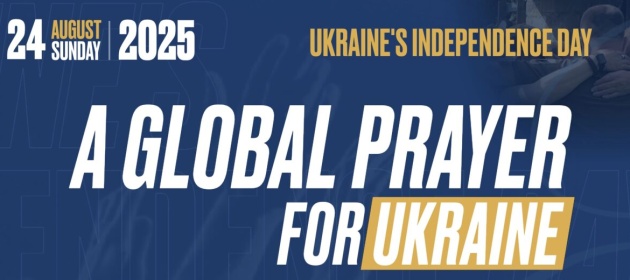From the independence in 1991 to the ongoing war sparked by Russia’s invasion, Ukraine’s efforts to recover and assert its true history have become acts of resistance, healing, and hope.
![Globus monument at the independence square in Kyiv. / Photo: [link] Tina Hartung[/link], Unsplash CC0.](https://cms.evangelicalfocus.com/upload/imagenes/688f3e29b97b3_tinahartung940.jpg) Globus monument at the independence square in Kyiv. / Photo: [link] Tina Hartung[/link], Unsplash CC0.
Globus monument at the independence square in Kyiv. / Photo: [link] Tina Hartung[/link], Unsplash CC0.
This is the last in a series of four addressing the persistent Russian efforts to hijack Ukraine’s history. Yo can read the first here, the second here and the third here.
History is not merely a record of the past, it is a battleground of meaning.
For Ukraine, the struggle over historical truth is more than academic. It is existential. Memory itself is a contested space—one where empires fight to control not only borders, but narratives.
Where Stalin rewrote Ukraine’s past to deny its nationhood, modern Ukraine has spent the last three decades trying to reclaim it.
From the moment of independence in 1991 to the ongoing war sparked by Russia’s 2022 full-scale invasion, Ukraine’s efforts to recover and assert its true history have become acts of resistance, healing, and hope.
The fall of the Soviet Union in 1991 was not just the end of an empire. It was the lifting of a historical fog. For the first time, Ukrainians could look into the dark corners of their past without censorship or fear.
KGB archives were opened, revealing the full horror of Stalinist terror: the Holodomor famine, political purges, suppression of intellectuals, and religious persecution.
Mass graves, long hidden, were unearthed. Survivors, silenced for decades, were finally allowed to tell their stories.
This wasn’t only an academic revelation. It was an act of collective psychological liberation. Ukrainians could finally name their trauma, and in doing so, begin to heal. The truth, long buried, became a tool not of division, but of dignity.
Ukraine’s post-Soviet nation-building project was also a memory project. Schools rewrote their curricula to include erased chapters of national history: the Executed Renaissance of the 1930s, the Ukrainian Insurgent Army’s resistance during and after World War II, and the brutalities of Soviet repression.
Scholars from the Ukrainian diaspora contributed generously to this work, bringing research, resources, and personal testimony. In 2008, the Holodomor Museum opened in Kyiv, marking a major step in public commemoration.
Across the country, streets once named after Soviet generals and ideologues were renamed after Ukrainian poets, activists, and heroes. Soviet monuments began to fall, not out of vengeance, but as part of a reckoning.
This wasn’t historical amnesia. It was historical honesty. For many Ukrainians, to remember rightly was to reclaim agency, to refuse Moscow’s imposed narratives, and to recognize the cost of their own survival.
In 2015, Ukraine passed sweeping decommunization laws that outlawed Soviet symbols in public spaces, opened up national archives, and banned the denial of the Holodomor as genocide.
More than a thousand Lenin statues came down. Documents once classified by the KGB became accessible to every citizen.
These moves were controversial. Some critics, especially in eastern regions, saw them as attempts to erase a shared Soviet legacy. But for most Ukrainians, decommunisation was not about erasing the past, it was about confronting it.
It was a declaration that myths imposed by foreign rulers would no longer define Ukrainian identity. The truth was not always easy, but it was essential.

The Kremlin responded not with introspection, but with aggression. Vladimir Putin, himself a former KGB officer, began crafting a revisionist narrative of his own.
He publicly claimed that Ukraine was not a real country, that its borders were artificial, and that its history was part of a greater Russian destiny.
Decommunisation was branded “Nazification” by Russian propaganda, and Ukraine’s 2014 Maidan Revolution was painted as a Western-backed fascist coup. This disinformation campaign was not just about public opinion, it became the ideological groundwork for military invasion.
Russia justified the annexation of Crimea and the war in Donbas through a warped historical lens, portraying itself as the defender of a shared “Russian world.”
In 2022, as Russian tanks rolled into Ukraine, Putin framed the invasion as a ‘rescue mission’—a restoration of imperial unity. Once again, history was being weaponised. But this time, Ukraine was ready to resist, not only with arms, but with truth.
Today, Ukraine’s memory work has become more urgent—and more creative—than ever. Across the country, local museums, memory walks, and digital storytelling projects are flourishing.
Survivors of Stalinist terror are interviewed for podcasts and school projects. Churches host exhibitions on cultural erasure and spiritual resilience. Artists use murals and music to tell stories long suppressed. These are not just acts of remembrance; they are acts of sovereignty.
Youth education is central. In a digital age rife with Russian disinformation, Ukrainian schools are teaching students not only what to remember, but how to remember critically.
Historical literacy is a form of national defense. When history is manipulated to justify invasion, then history-telling becomes a moral duty.
Truth is not optional for a free people. Ukraine’s struggle to reclaim its history is foundational. To be sovereign means owning your story. In reclaiming the truth, Ukraine is reclaiming more than the past. It is reclaiming the future.
History is not neutral. It is always shaped by who tells it—and why. For Ukraine, telling its own story is a matter of justice, resistance, and survival.
And for the world, Ukraine’s historical sovereignty is not just an internal matter—it is a beacon of what it means to face empire with courage, to answer lies with truth, and to say: “We remember.”
Jeff Fountain, Director of the Schuman Centre for European Studies. This article was first published on the author's blog, Weekly Word.

Las opiniones vertidas por nuestros colaboradores se realizan a nivel personal, pudiendo coincidir o no con la postura de la dirección de Protestante Digital.
Si quieres comentar o